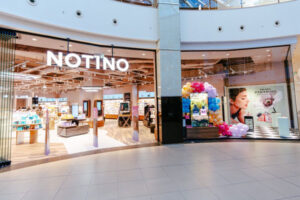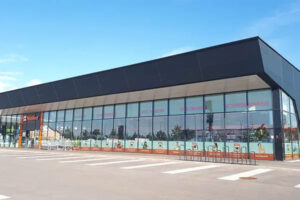ACROSS: Steffen, it’s been a year since we have spoken, and according to the latest industry research publications, the investment activity in the European retail sector has slowed down considerably compared to previous years. Do you have the same impression?
Steffen Hofmann: Markets, indeed, have moved on, and, as expected, we seem to have entered a very interesting phase of the cycle. On the one hand, there is continuous talk about disruption in the field of retail real estate, and some investors are shifting strategic portfolio asset allocations away from retail properties to balance out perceived portfolio risks. On the other hand, rare deal opportunities have arisen in exactly the same space as a consequence of this move. We believe that this setting might offer potential purchasers the opportunity to access prime assets in very sustainable retail locations, which simply would not have been available to them before.
ACROSS: Your view implies that you are convinced that physical retail space will continue to play an important role 20 years from now, doesn’t it?
Hofmann: Correct.
ACROSS: Does that mean that owners of large retail properties should be more relaxed about their holdings and wait for the current market uncertainty to settle?
Klaus Mennickheim: No, that’s not what we are saying. What is commonly labeled as disruptive evolutions in the retail real estate sector has a meaningful impact on asset management strategies for retail properties across all matured economies in Western Europe. In some markets and for certain type of assets, however, we have observed an over-reaction. That’s typical during times like these, when great deal opportunities arise for those who are able to act, while everybody else watches from the sideline.
ACROSS: What do you see as the biggest challenge for institutional investment managers in this market?
Mennickheim: Stock selection is the key this season. Investors will increasingly look at KPIs and progressively try to understand underlying economic fundamentals from a local market research point of view. The investment manager’s true challenge in this phase of the cycle is sorting the wheat from the chaff and picking the right assets. The second challenge involves getting your investment committees to back your deals.
ACROSS: Steffen, based on your team’s expectations regarding future evolution, which is always uncertain, what does the new formula for future success in the shopping center sector look like?
Hofmann: There is no catch-all formula anymore. The crucial question for the physical retail destinations of the future is whether or not their created offers will remain relevant to their local customers. A clear positioning strategy is of the highest priority. Ever-evolving technological standards and the subsequent adaption of store concepts will actually contribute to making physical retail space look, function, and perform better than many people currently think. Differentiation through placemaking by way of sophisticated space design, superior customer experience, an expandable share of food and beverage offer in the branch-mix, elements of entertainment and events, along with an offer of convenient community services and complementary mixed-use components, will enhance customer satisfaction and impact the future performance outlook of shopping centers. Furthermore, we believe that the operator-related question is more relevant than ever.
ACROSS: Have you noticed any new investment patterns in your home market in recent years?
Hofmann: Let’s look at capital allocations of indirect institutional investors, such as insurance companies and occupational pension funds based in Germany, for example. This investor group represents an important share of the European real estate investment market as a result of their equity subscriptions in numerous fund vehicles. For roughly five years, this group has clearly favored hypermarket-anchored retail warehouse properties, regionally dominant retail parks, and hybrid malls over alternative types of retail properties as investment products. In Q4 2018, for the first time in market history, cap rates for out-of-town or edge-of-town retail parks in Germany were lower than those of prime, inner-city shopping malls. As a matter of fact, the asset class of retail parks has emerged as the absolute outperformer for retail investors who bought into this sub-sector during the right point in the cycle. Prices may have moved somewhat away from the underlying fundamentals, though.
ACROSS: How much of this dynamic evolution is fueled by the fact that these retailing formats are facing less pressure from their online competition?
Mennickheim: So far, convenience-oriented retail properties have, indeed, shown less dependency on the evolution of online retailing. Experts argue that German consumers are very price sensitive when it comes to the costs of food and beverage, a market particularity deeply rooted in the German culture. In this low-margin segment, online retailers can’t compete yet due to the relatively high costs of delivery services and the need for uninterrupted cooling chains. However, that may only be a question of time as millennials are willing to pay higher prices for food than previous generations, and innovative entrepreneurs are seeking ways to optimize the last mile. Incidentally, non-food articles offered by hypermarkets are strongly affected by online competition.
ACROSS: Following that logic, what’s the investment market’s rationale behind the booming asset class of retail parks?
Mennickheim: For German institutional investors aiming to generate stable income returns, diversification of portfolio risks is key to their allocation strategy. This includes a targeted spread of income risks over different properties and locations as well as the minimization of future exit risks. Due to their smaller lot-size, retail parks have a larger universe of potential buyers. Even newly launched fund vehicles can quickly build up a diversified portfolio. German hypermarket operators, which are the most important anchor tenants in this sector, are willing to enter into 10-, 15- or even 20-year leases, which results in longer overall WAULTs and allows them to secure lower debt-finance costs as banks appreciate this contractually secured income portion. At the same time, these occupiers usually offer first-class rental covenants, which, likewise, contribute to an attractive risk-adjusted return profile of the asset class.
ACROSS: Are there any major differences between retail parks and shopping malls from an asset management perspective?
Mennickheim: The asset class of retail parks is certainly less asset management intensive. Strategic repositioning projects, such as the comprehensive restructuring of an entire shopping center, are clearly the most complex and also capital-intensive asset management initiatives. Not every investment house is adequately resourced to deal with these complexities. Notwithstanding that, such projects can be very rewarding – once they have been completed. They allow for the implementation of the latest conceptual trends and attract new brands, which then attract more visitors and help to drive footfall and sales on site. Having a refurbished shopping center in your portfolio is great. Getting there can be a real pain.






